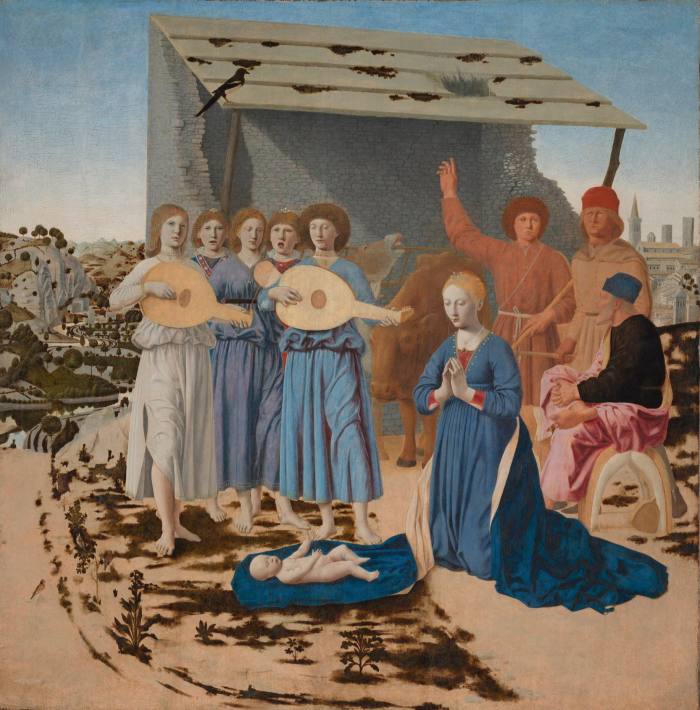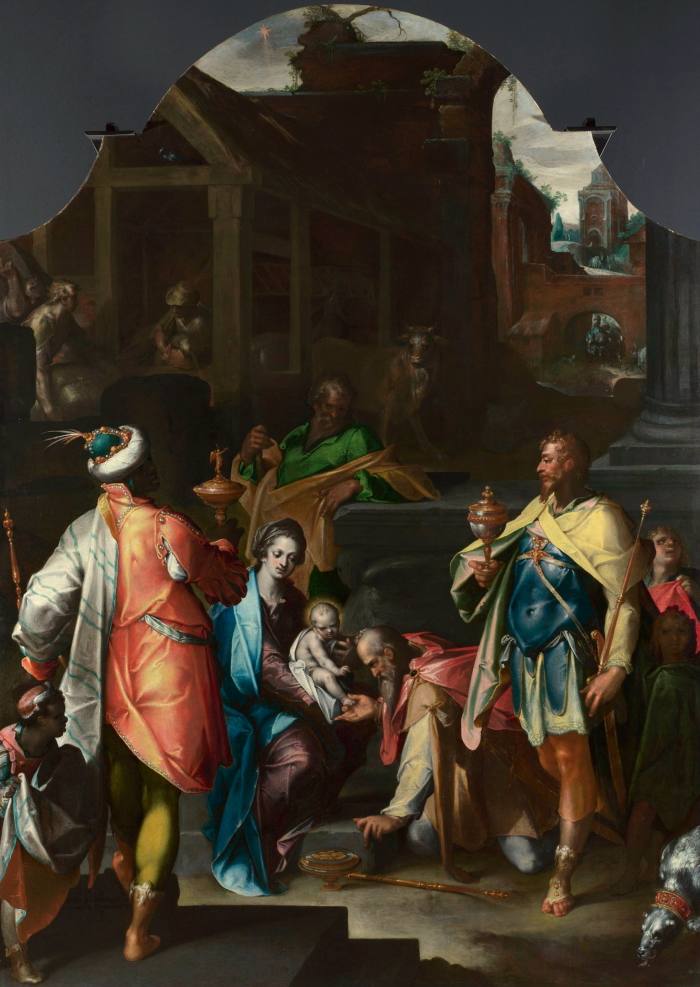“But, my dear Sebastian, you can’t seriously believe it all? . . . I mean about Christmas and the star and the three kings and the ox and the ass.”
“Oh yes, I believe that. It’s a lovely idea.”
“But you can’t believe things because they’re a lovely idea.”
“But I do. That’s how I believe.”
Evelyn Waugh, Brideshead Revisited
About a third of the paintings in the National Gallery depict Christian subjects, and most need unpacking for today’s audiences. But the “lovely idea” of the Nativity and Adoration is instantly comprehensible — indeed, it is through paintings that the narrative was codified and its details became familiar. The Gospels do not mention how many Magi visited or describe Joseph; it is painters who lastingly formulated the trio of kings, made one of them black and cast Joseph as old, bearded, awkward and impotent — the comic turn.
Whatever you believe, how this iconography unfolded is a wonderful story in itself, and the National Gallery through centuries of wildly imaginative Christmas paintings is beautifully able to tell it.
Its oldest picture, Margarito d’Arezzo’s “The Virgin Enthroned” (1263-64), a fragile tempera panel rarely on show, includes a small Nativity in a cave where a reclining Mary, robed in blue (the most expensive pigment), gazes at the baby. But the subject is not prominent until the later 15th century, when Renaissance artists seized on its vast potential: for verisimilitude, emotional intensity, ornamentation, even political messaging.

Already in the 1470s-1490s comes tremendous diversity in approach according to regional context, creative sensibility, patrons’ demands. Haarlem painter Geertgen tot Sint Jans’ little nocturne “Nativity” depicts pale-faced Mary as blankly, deeply awestruck as any new mother, shining in the light radiating from her baby, while everyone else recedes in darkness. In Milan, Bramantino’s grandly architectural “Adoration” positions a regal Mary in a dazzling geometry of stone cornices and doorways. Botticelli’s parade of fashionable Florentines converging from opposite sides in his “Adoration” tondo was painted when the Medici were staging Epiphany processions as power displays of harmonious rule.
Giorgione in 1506 brings glowing Venetian colour: the holy family in brilliant ultramarine and gold, their visitors a play of warm chromatic rhythms. In Ferrara in 1527, the eccentric Dosso Dossi imagined the kings under a huge blood-red moon in discordant hues and distorted poses, as if they struggled to understand the miracle before them. By 1633, Poussin’s “Adoration of the Shepherds” feels secular: a pastoral Arcadia in nostalgic coppery-orange, the flowing drapery, marble columns, classicised figures infused with longing for antiquity.
Amid these riches, one of the most affecting Nativities is Piero della Francesca’s intimate, calm, spare rendering from the 1480s. After a three-year restoration, it returns, in what the gallery calls its “Christmas present for the nation”, to hang alone in a small room, recreating as closely as possible the private devotional setting in Piero’s home in Borgo Sansepolcro for which it was designed.

An aura of mystery immediately draws you. Posed before a ramshackle shed, the figures are static and strangely lack shadows. Angels strum stringless lutes. The limpid Virgin is ethereal. A single magpie surveys everything. The light across the tableau of characters and beige-green Tuscan hills and towers is crystalline yet subdued.
As often with Piero, a self-contained other world is conjured, and within it a silent centre: Mary’s introspective stillness. Kneeling between the band of angels and the ruddy shepherds grouped with Joseph, inelegantly perched on a donkey saddle and looking away, she connects divine and mortal. The Christ child lies on her lapis lazuli gown, extended across the parched ground — the tactile link between mother and son.
The painting was considered unfinished until this restoration, which has not only sharpened every detail, and repaired damage to one of the angel’s eyes, but has also, in revealing a heavenly light beam bursting through a gap in the shed roof, tilted interpretation towards the mystical. Probably influenced by St Bridget’s vision of Mary painlessly giving birth while kneeling in prayer, a popular account in 15th-century Italy, Piero painted the supernatural as the real. His shadowless, miraculous scene, seemingly simple, is an ordered, perfected version of human existence.

Emerging from Piero into the surrounding galleries is to return to everyday life in its rowdy confusion, as envisioned in Flemish art. The black king splendidly dressed in white and offering a gleaming intricate boat, topped by a crystal orb — an allusion both to Christianity’s wide reach and Flemish wealth and global trade — dominates Pieter Bruegel’s “Adoration”, packed with haggard, jostling figures. Jan Brueghel crams a whole wintry city into his little lustrous gouache “Adoration”, the air crisp, the sky star-bright. Soldiers try to placate the crowds, but the news is out and people throng towards the flimsy hut. The exotic visitor and his gift are repeated here; ogled by envious locals, he stirs unease in each painting: the Brueghels are astute social commentators.
Jan Gossaert’s monumental “Adoration” always astounds, every inch animated by precious descriptions of material delight — treasures of goldsmiths, metalworkers, embroiderers, weavers — beneath a heavenly host representing the immaterial. Here too the black king, proud, patient, stunningly attired, stands out in a composition whose every figure — from multicoloured angels to dogs sniffing the pavement — is individualised within a magnificent unity.
Gossaert, the first Flemish artist to visit and learn from Rome, was an example for his compatriots. One, Bartolomeus Spranger, later uniquely fused Netherlandish realism and Italian mannerism; his swaggering, satiny “Adoration” (1595), resembling a court scene with balletic kings and mischievous page boys, is a piquant curiosity.

By now, Counter-Reformation theatricality was shaping religious art, led in the 17th century by Guido Reni. In his heartfelt, overblown five-metre “Adoration of the Shepherds” — rapt worshippers beneath rosy clouds of putti — the genre reaches its limits of inventiveness. Only one of Trafalgar Square’s three-score Christmas paintings postdates 1670.
Renaissance Nativities and Adorations belong to a golden moment when artists enthralled with recreating nature still worked within a sacramental culture. The National Gallery contains one tremendous, enigmatic exception: in his ecstatic “Mystic Nativity”, Botticelli turned away from naturalism to a near-Gothic formal patterning. Dancing angels bearing olive branches encircle Mary and Jesus, gigantic in proportion to the other figures. Joseph curls up asleep. Small devils scurry away.

The only painting Botticelli signed, “Mystic Nativity” bears numerous half-legible inscriptions, explaining its creation in 1500 in the aftermath of “the troubles of Italy” — war and Savonarola’s religious fundamentalism. But it’s a painting for all time. In its exquisite artifice, coherence is won from chaos, and on the angels’ fluttering scrolls the words ring out: “On earth, peace, goodwill toward men.”
Stay connected with us on social media platform for instant update click here to join our Twitter, & Facebook
We are now on Telegram. Click here to join our channel (@TechiUpdate) and stay updated with the latest Technology headlines.
For all the latest Art-Culture News Click Here
